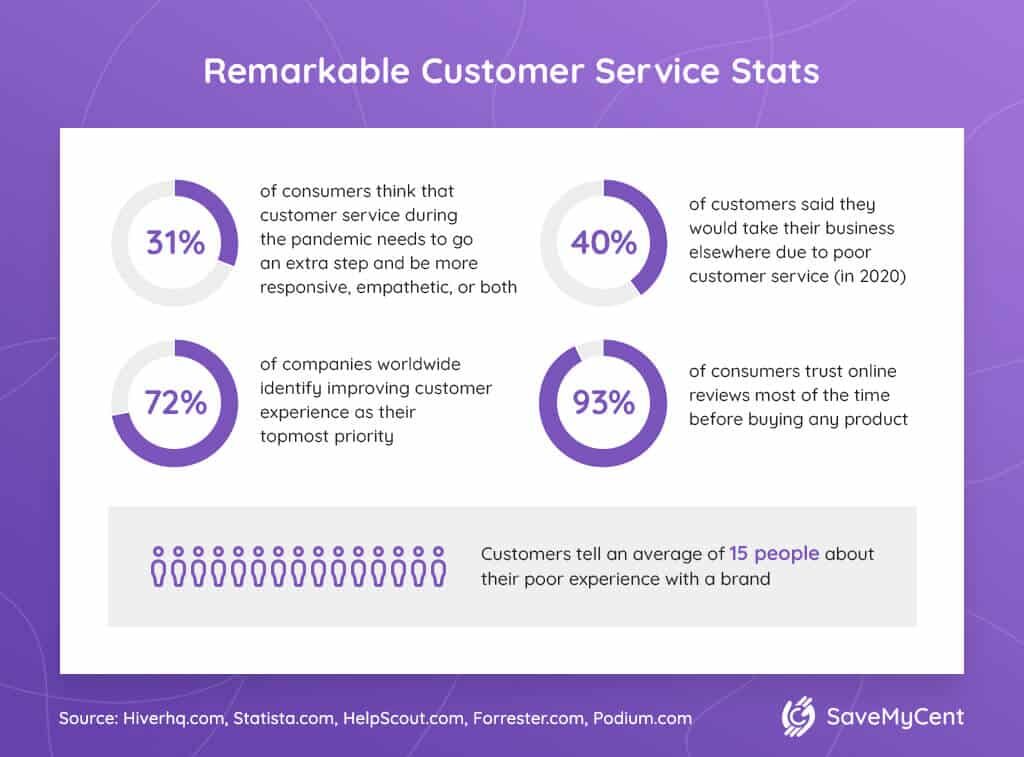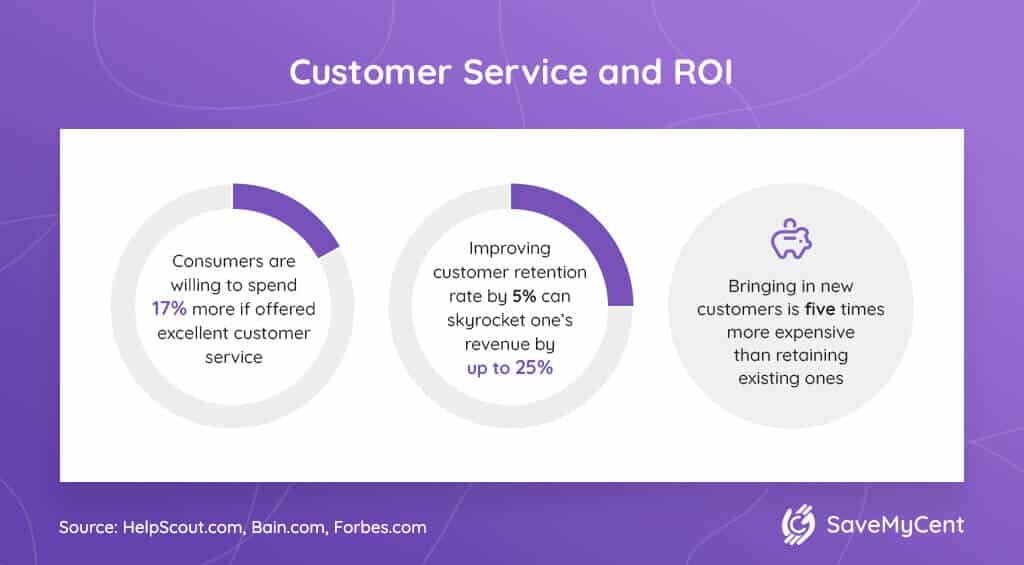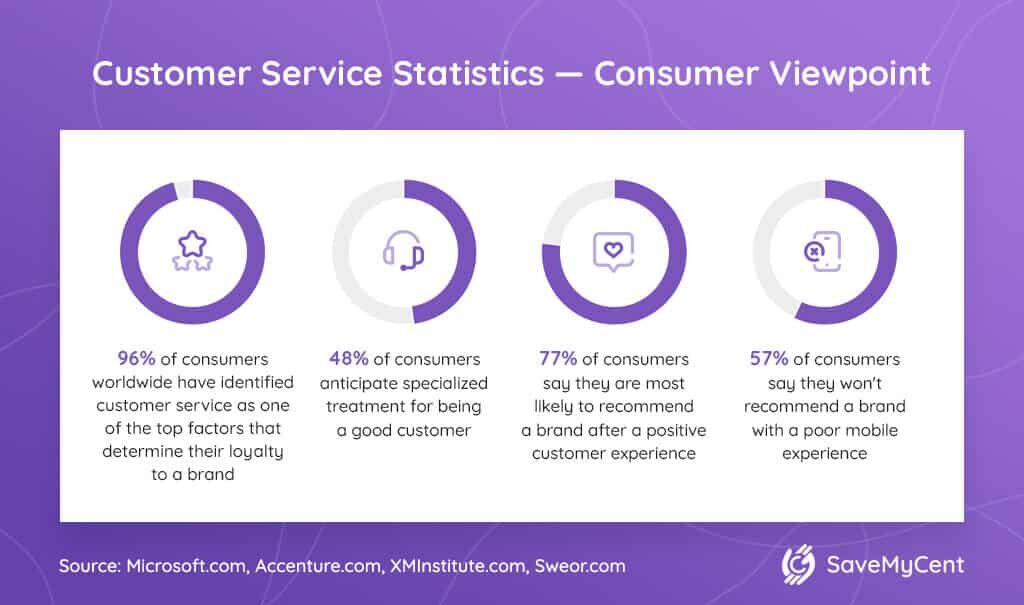In the past, if you had a good product at a competitive price, you had everything to remain relevant in the eyes of consumers. However, today, given the increasing competition across all business sectors worldwide, setting a competitive price alone isn’t good enough.
According to the customer service statistics, there is a new determining factor — the one the big players across various industries have already been utilizing to stay ahead of the competition. This factor is known as customer service.
Customer service is all the assistance you offer to your customers at all stages of their interaction with your brand. It’s what will determine the overall experience of your customers. Excellent customer service will ensure that your buyers remain loyal and choose to continue doing business with you. Horrible customer service, on the other hand, is bad news for your business.
Discussed in this article are some of the most sought after customer service figures. Let’s get started.
Fascinating Customer Service Facts (Editor’s Choice)
- Consumers are willing to spend 17% more if offered excellent customer service.
- 40% of customers said they would take their business elsewhere due to poor customer service.
- 51% of customers are likely to cease interacting with a brand after just one negative customer experience.
- The most commonly used customer service channel is email.
- 95% of consumers worldwide have cited customer service as one of the top factors that determine their loyalty to a brand.
- 93% of customers are likely to return for another round of business with you if your customer service the previous time was top-notch.
- It takes 12 positive customer experiences to cover up for just one poor customer experience.
- Bringing in new customers is five times more expensive than retaining existing ones.
Noteworthy Customer Service Statistics
Here, you’ll find the stats packed with practical tips that you can start implementing from the get-go to make your business even better.

1. 31% of consumers think that customer service during the pandemic needs to go an extra step and be more responsive, empathetic, or both.
(Hiver)
As the pandemic hit, the consumers expected customer services to adjust their approach. Understanding the consumers’ experiences at a human level and talking to them with more attention and care could mean a lot for customer support quality.
2. 58% of customers prefer phone calls when it comes to solving urgent matters.
(Accenture)
This is especially important during times of crisis such as the pandemic. Efficiency is key, especially when people have enough to worry about. Reducing waiting times is more important than ever.
3. In 2020, 40% of customers said they would take their business elsewhere due to poor customer service.
(Statista)
It’s certainly not good for business.
According to the statistics on the cost of poor customer service, unsatisfied customers, who leave without dropping complaints or feedback, are a danger to the growth of your business.
Why’s that?
These unsatisfied customers will likely give negative reviews about your brand to their colleagues, further driving away potential customers.
On the other hand, that is 4% less than in 2019, showing that customers may have taken the stressfulness of last year into consideration when it comes to customer service employees.
4. 51% of customers cease interacting with a brand after just one negative customer experience.
(Help Scout)
According to the customer experience statistics, just one bad customer service experience is all it takes to lose more than half of your customers. Allow the number of bad customer service experiences to go as high as three, and you might lose 92% of your loyal customers.
To make matters worse, the statistics show that 50% of customers have moved over to a competitor who satisfies their needs through excellent customer service after they stopped doing business with a particular brand.
5. Customers tell an average of 15 people about their poor experience with a brand.
(Help Scout)
Ever heard of the saying “Bad news spreads like wildfire?”
The statistics from customer service studies indicate that 95% of customers will talk with others about their poor customer experience with a brand. Interestingly, fewer people (87%) are willing to talk with others about their positive experience. What’s more, men talk the most about their poor customer experience (average of 21 people), whereas women will most likely share their experience with an average of ten people.
However, this is not all bad news for businesses as the customer satisfaction statistics also show that out of those willing to talk about their positive experience with a brand, 72% will tell six or more people.
6. 72% of companies worldwide identify improving customer experience as their topmost priority.
(Forrester)
With 81% of companies worldwide competing based on just customer experience in 2020, it’s no surprise that more companies are now willing to invest their time, effort, and finance into running the best possible customer service.
Via web forms such as Net Promoter Score (NPS), companies are now collecting customer feedback through comments, opinions, and suggestions. That way, it’s easier to channel the necessary resources into what customers need and meet market expectations, as revealed by the digital customer service statistics.
7. 77% of consumers will most likely favor a brand that invites customer opinions/feedback and acts on them.
(Microsoft)
According to customer support statistics, accepting customer feedback and acting on it is an excellent customer service technique. It also guarantees that you stay one step ahead of your competitors.
Customer feedback provides businesses with invaluable data about what makes a brand stand out in the market and what customers expect from it at every point in time. Your customers want to feel like they are a part of something big that is happening with your brand. Thus, if you act on their feedback, your customers are more than likely to repay you with their loyalty.
8. 93% of consumers trust online reviews most of the time before buying any product.
(Podium)
In this digital age, it’s almost impossible for businesses to overlook the importance of online reviews. Around 84% of consumers cited customer service as one of the key factors that help them decide if they should do business with a particular brand.
Another reason to focus on gathering online reviews is that most consumers turn to them before making a purchase online or in-store. What’s more, the retail customer service statistics show that 72% of customers will not make a purchase until they have checked online reviews.
9. 93% of customers are likely to return for another round of business if customer service the previous time was top-notch.
(HubSpot)
Customers want to support businesses they love. If you make sure every interaction a customer has with your brand leaves a positive impression, you will most certainly witness more customers coming back for your products and services. Numerous statistics on customer service results can testify to it since they show that the increased number of repeat customers is the outcome of excellent customer service.
Customer Service ROI Statistics
The ROI generated by excellent customer service is enormous. Reduced cost of operation, increased sales, and retention of loyal customers account for most of it. Let us dive into fascinating customer service stats that will show us how businesses benefit from offering good customer service.

10. Consumers are willing to spend 17% more if offered excellent customer service.
(Help Scout)
This figure is up from 14% recorded in 2014. It goes up to 21% for Millennials. What’s more, over two-thirds (68%) of customers are willing to spend more with a company that delivers excellent customer service. Another 52% say that they have even made an additional purchase following a positive customer service experience.
11. Improving customer retention rate by 5% can skyrocket one’s revenue by up to 25%.
(Bain & Company)
Companies that earn up to $1 billion annually can expect to generate an average of $700 million as additional revenue within three years of investing in customer service.
Not only will such improved customer service satisfy your customers’ needs, but it will also bring in more sales through word-of-mouth advertising. What’s more, existing customers will be compelled to spend more on your products and services.
12. Substandard customer service costs companies worldwide an average of $62 billion yearly.
(Salesforce)
According to the statistics on customer service, for countries like the US, this figure rises to $1.7 trillion annually. Regardless of who you are, how good your product is, and how effective your services are, your customers can always opt for an alternative. If they choose to stick with your brand, they want to be heard and valued. Anything short of that, and they will switch to your competitors that are willing to meet their needs.
13. 73% of businesses worldwide with an “above average” customer service rating perform better financially than their competitors.
(Help Scout)
Many facts about customer service point to the benefits of good customer service. Among them are the increased number of repeat customers, word-of-mouth advertising, positive reviews on online forums and social media. All these will enable you to cut the advertising expenses. That way, your business will have enough funds for other projects to take your brand to another level.
14. Bringing in new customers is five times more expensive than retaining existing ones.
(Forbes)
To bring in a new customer, you have to start advertising from the top of the sales funnel to the bottom. To bring in new leads and convert them to paying customers, you have to spend money on advertising at every step of the funnel. First and foremost, it covers bringing in cold traffic and turning it into warm traffic. It then extends to pitching your product or service to the so-called hot traffic at the bottom of the funnel.
That said, retaining existing customers is significantly cheaper. These customers are already at the bottom of the funnel as the hot traffic. If your customer service was good the first time, they are likely to return for another purchase. Plus, you get to skip the nurturing part (which costs money) and go straight to upselling, cross-selling, or introducing new products to them at any point in time.
Customer Service Channel Statistics
The customer service statistics for 2022 state that today’s customers are more tech-savvy and more demanding. What’s more, they have the bucketload of market options at their fingertips.
In the past, customer service depended on phone calls, in-store agents, and fax messages to attend to customers. With the advancements in technology, the concept of customer service channels has become broad and has introduced multiple service touchpoints in the process.
Here, we take a look at some customer service channels and what customers expect from them.
15. Email was the preferred channel of 48% of Gen Z and 35% of Millennials in 2020.
(Hiver)
According to the customer service facts for 2020, email is the most commonly used customer service channel. What’s more, customers expect customer service representatives to respond to their emails within an hour. Customer service industry statistics inform us that companies that respond to customer emails fast bolster their chances of gaining trust and loyalty.
16. Customers are willing to wait on hold for an average of 11 minutes before hanging up.
(Help Scout)
With the advent of social media, live chat, and online review forums, many businesses overlook one of the oldest and most effective customer service channels — phone calls. Numerous statistics, however, make us reevaluate their importance. If you want to make a good impression, it’s better to play it safe and make sure your customer service representatives do not make customers stay on hold for more than 11 minutes.
17. Customers are only willing to wait 45 seconds for a reply from your customer service agents in a live chat.
(LiveChat)
Social media customer service statistics indicate that live chat is most commonly used among younger generations. Some of its benefits include the freedom to multitask, access to a personal agent, and fast response time.
With the amount of time people are spending online these days, it would be unwise for businesses to overlook the advantages of adding a live chat window to their website, mobile app, or social media handles.
It’s also important to note that the attention span of consumers is shrinking. Hence, the faster a business responds to customers’ live chats, the better.
18. 57% of consumers prefer companies that can be reached via email, social media platforms, and live chat over the ones using the voice-based customer support.
(Ameyo)
With over 4.6 billion internet users, this preference shouldn’t come as a surprise. What’s more, social media and email have been around for quite some time now. Considering that most people communicate via social media platforms and email these days, it’s understandable why customers opt for these particular mediums to interact with customer service representatives.
Many social platforms, in turn, have realized the importance of customer services, and now we can witness them putting a premium on enabling business-customer interactions via an array of functionalities.
That said, the statistics show that 48% of customers would rather call a customer service representative to resolve sensitive issues such as financial disputes.
19. Social media customer service stats claim that 33% of consumers have reached out to customer service using Facebook or other social media channels, excluding Twitter.
(Forrester)
Social media stats place Facebook as the most popular social media platform in the world. Its user-friendly and easy to navigate website ensures that everyone can utilize the platform.
As mentioned before, simplicity is what draws customers in; that’s why it’s not surprising that many consumers turn to Facebook to contact customer service representatives.
20. At least three different communication channels have been used by 66% of consumers to contact customer service.
(Microsoft)
According to customer service research, 90% of consumers expect consistent customer service across all channels of communication. Providing an omnichannel experience has become a vital part of customer service over the last years.
What’s more, 50% of businesses worldwide have cited providing a seamless experience across multiple channels as one of their main challenges. That said, the percentage of companies investing in the omnichannel experience has increased to 80% from 20%.
21. When consumers contact your customer support through social media, most of them are willing to wait for a response for 24 hours maximum before tagging your customer service as “bad.”
(Statista)
The smaller the percentage of problems with your customer service, the higher the likelihood of getting back to your customers just in time.
Today’s customers want to get a response as soon as possible. Around 26% of these customers expect a response within four hours, 31% want a response under two hours, and 37% expect a response under 30 minutes. What’s more, as many as 38% of consumers cited getting their issues resolved quickly in a single interaction as the most important aspect of good customer service.
22. 68% of customers claimed that a customer representative was instrumental in their recent positive customer experience.
(Help Scout)
In addition to that, 62% of consumers identified a customer rep’s resourcefulness as one of the key reasons they stayed loyal to a brand.
Having in-depth knowledge about one’s company is a necessity. If your customer service reps are not up-to-date about your products and services, they are unlikely to meet most customers’ needs.
Customer Service Statistics on Your Customers’ Needs and Wants
The best way to learn about customers’ needs and wants is undoubtedly to hear directly from them.
Here, we take you through some of the most crucial statistics collected through customer feedback.

23. 96% of consumers worldwide have identified customer service as one of the top factors that determine their loyalty to a brand.
(Microsoft)
The importance of customer loyalty cannot be overlooked. Loyal customers are seven times more likely to test your new offerings, five times more likely to buy from you again, and four times more likely to refer others to your brand, the customer support statistics reveal.
24. 48% of consumers anticipate specialized treatment for being a good customer.
(Accenture)
When contacting a company they have interacted with before, 72% of consumers expect it to have their basic info and purchase history. It further cements the importance of personalization in customer service.
Reports point out that personalized customer experiences can improve online conversion rates by about 8%. Customer service stats also show that 49% of buyers have made impulse purchases after receiving a more personalized experience. In other words, your business is better off taking personalization seriously.
25. 64% of customers say they value customer experience much more than price.
(Help Scout)
Customers are four times more likely to purchase from your competitors if your customer service is unsatisfactory. Therefore, it’s a much safer bet to compete on customer service than on price, especially if you operate in crowded markets.
As mentioned prior, if you want to concentrate on delivering good customer service, you should invest in creating an omnichannel customer experience. According to proactive customer service statistics, if you successfully implement omnichannel services, you will be able to retain 89% of your customers.
26. 77% of consumers say they are most likely to recommend a brand after a positive customer experience.
(XM Institute)
Excellent customer service is more impactful than all of your marketing efforts combined, and that is a fact. Great customer service ensures that customers get the best experience when interacting with your brand. A satisfied customer will bring in more sales to your company through recommendations, word-of-mouth advertising, and positive reviews. All of these will portray your brand in a good light.
27. 67% of customers worldwide believe that customer service as a whole is improving.
(Microsoft)
It seems that more and more businesses realize the potential of customer service. Customer service data indicates that as many as 81% of Americans have noticed positive changes in customer service.
Following this, If your business is not optimizing its customer service in times like these, it will be almost impossible for you to be at the top of your game.
28. 57% of consumers say they won’t recommend a brand with a poor mobile experience.
(Sweor)
What’s more, 50% of customers will stop visiting a brand’s website (even if it’s their favorite) if it’s poorly designed on mobile. With over half of all internet traffic worldwide now coming from mobile devices, it’s no surprise that 84% of companies with good customer service have mobile-focused customer service.
Difficulty in navigation, unhelpful search results, and slow load time are the issues mobile customers complain about the most. Fix them, and your business will benefit from all the mobile traffic.
Wrap Up
Customer service plays a big role in how customers feel about your brand in the long run. Customer service statistics unfailingly prove that businesses that prioritize delivering good customer service enjoy the benefits of drawing in new customers, increasing sales, and reducing marketing costs.
Moreover, if you put more effort into building omnichannel experiences and designing efficient mobile platforms, you will be able to stay ahead of your competition.
Go through our statistics again, if needed, to come up with the best fitting customer service strategy for your business.
FAQs
Q: What percentage of customers pay more for customer service?
Multiple statistics state that customer service impacts consumers’ purchase decisions the most. Nowadays, it’s the businesses that offer the best customer experience 24/7 that retain more customers, and that is a fact. What’s more, around 68% of customers are willing to pay more for a product or service if a brand offers excellent customer service.
Q: What percentage of customers will actually complain when they are dissatisfied with service?
Only 4% of customers complain directly to a company about their bad customer service.
Reports go further to inform us that 96% of customers never complain about bad customer service, and 91% of them will simply leave (without complaining) and never come back.
There are various reasons why customers don’t complain to a brand about its poor customer service. Many customers do not file a complaint because the overall process is too complicated. There are also companies that do not ask for feedback; thus, it’s practically impossible to share your experience. Some customers complained directly before; however, nothing was done about their complaints, which left these consumers demotivated and uneager to complain again. Many customers don’t even bother complaining and take their business elsewhere right away.
Q: Why is customer service important?
Customer service is important to your business because it’s a part of your business that can make or mar your marketing efforts.
Customer service facts inform us that excellent customer service will ensure that you retain most of your customers, turning them into loyal buyers and having them spend more on your products and services. It also goes further to ensure that you spend less on marketing — your satisfied customers advertise your brand through various means, such as word-of-mouth advertising, online review forums, and social media.
Q: What are the three most important things in customer service?
The most important factors in customer service are timeliness, reliability, and effective communication.
Today’s customers are time-conscious and have very little patience. They are willing to stay on hold for up to 11 minutes before hanging up. That should give you a hint of what to expect when establishing customer service channels.
Overall, customers respond well to businesses that are fast and efficient in delivering their customer service.
Reliability is just as important. It deals with the quality of solutions offered through various customer service channels. If customers deem your service reliable, they will trust you, and they won’t hesitate to turn to your business when they have difficulties.
Communication with customers is another crucial aspect of customer service. Effective communication enables businesses to meet their customers’ needs, collect feedback, and then implement the most constructive ideas in their customer service.
Q: What is the main role of customer service?
The main role of customer service is to ensure that consumers get the best customer experience a brand can offer.
Customer service is what helps businesses stay ahead of their competition. It’s also a gateway for businesses to turn buyers into loyal customers, thus increasing sales and business revenue.
Q: What makes a good customer service?
Good customer service should leave a lasting impression on your customers. This lasting impression will compel customers to come back and do business with you again and again, provided you continue to deliver excellent customer service at all times. Efficient customer service can also lead to an overall reduction in the cost of marketing and advertising, as customer service statistics reveal.
Resources:







![How to Get Free Clothes From Shein? [2024 Guide]](https://savemycent.com/wp-content/uploads/2023/09/How-to-Get-Free-Clothes-From-Shein-336x220.png)
